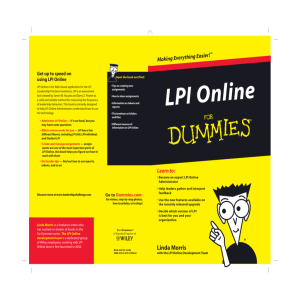LPI101 - LPIC-1 EXAM PREP (COURSE 1)
advertisement
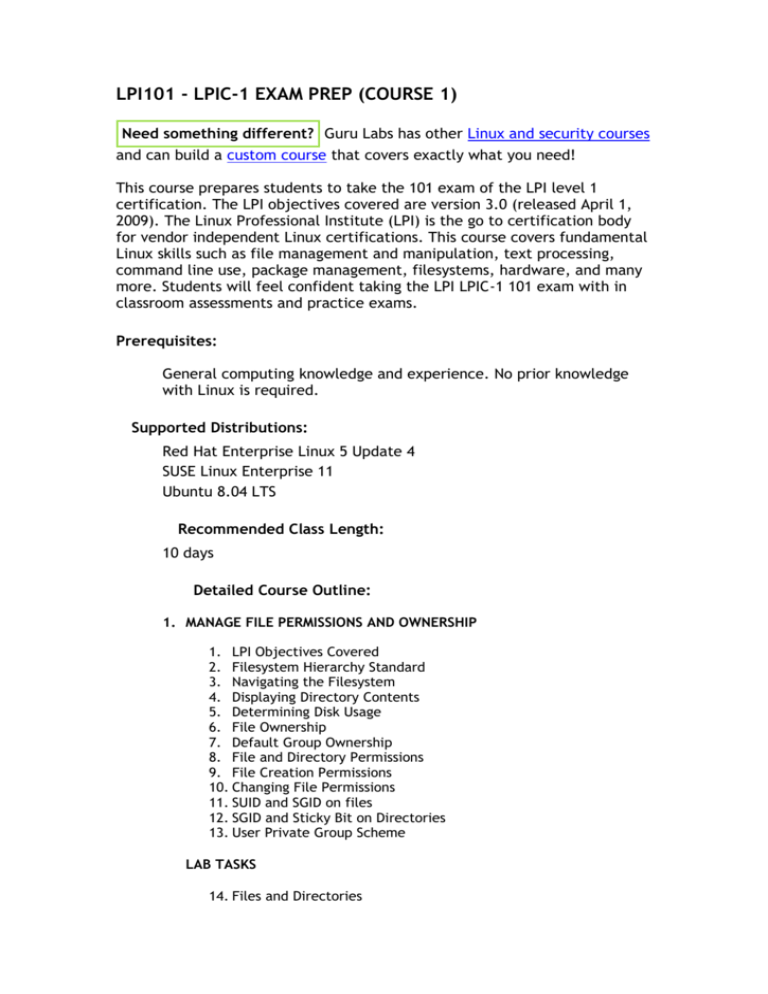
LPI101 - LPIC-1 EXAM PREP (COURSE 1) Need something different? Guru Labs has other Linux and security courses and can build a custom course that covers exactly what you need! This course prepares students to take the 101 exam of the LPI level 1 certification. The LPI objectives covered are version 3.0 (released April 1, 2009). The Linux Professional Institute (LPI) is the go to certification body for vendor independent Linux certifications. This course covers fundamental Linux skills such as file management and manipulation, text processing, command line use, package management, filesystems, hardware, and many more. Students will feel confident taking the LPI LPIC-1 101 exam with in classroom assessments and practice exams. Prerequisites: General computing knowledge and experience. No prior knowledge with Linux is required. Supported Distributions: Red Hat Enterprise Linux 5 Update 4 SUSE Linux Enterprise 11 Ubuntu 8.04 LTS Recommended Class Length: 10 days Detailed Course Outline: 1. MANAGE FILE PERMISSIONS AND OWNERSHIP 1. LPI Objectives Covered 2. Filesystem Hierarchy Standard 3. Navigating the Filesystem 4. Displaying Directory Contents 5. Determining Disk Usage 6. File Ownership 7. Default Group Ownership 8. File and Directory Permissions 9. File Creation Permissions 10. Changing File Permissions 11. SUID and SGID on files 12. SGID and Sticky Bit on Directories 13. User Private Group Scheme LAB TASKS 14. Files and Directories 15. Disk and Filesystem Usage 16. File and Directory Ownership and Permissions 2. CREATE, DELETE, FIND, AND DISPLAY FILES 1. LPI Objectives Covered 2. Directory Manipulation 3. File Manipulation 4. Deleting and Creating Files 5. Physical Unix File Structure 6. File system Links 7. File Extensions and Content 8. Displaying Files 9. Previewing Files 10. Displaying Binary Files 11. Searching the File system 12. Alternate Search Method 13. Shared Libraries LAB TASKS 14. File and Directory Manipulation Commands 15. File Examination & Search Commands 3. WORK WITH ARCHIVES AND COMPRESSION 1. 2. 3. 4. 5. 6. LPI Objectives Covered Archives with tar Archives with cpio The gzip Compression Utility The bzip2 Compression Utility The PKZIP Archiving/Compression format LAB TASKS 7. Archiving and Compression 8. Using tar and cpio for Backups 4. PROCESS TEXT STREAMS USING FILTERS 1. LPI Objectives Covered 2. Producing File Statistics 3. Searching Inside Files 4. The Streaming Editor 5. Text Processing with awk 6. Replacing Text Characters 7. Text Sorting 8. Duplicate Removal Utility 9. Extracting Columns of Text 10. Merging Multiple Files LAB TASKS 11. Text Processing 5. WORK ON THE COMMAND LINE 1. LPI Objectives Covered 2. Role of Command Shell 3. Shells 4. Identifying the Shell 5. Changing the Shell 6. sh: Prompts 7. bash: Bourne Again Shell 8. bash: Command Editing 9. bash: Command Completion 10. Shell/Environment Variables 11. Key Environment Variables LAB TASKS 12. Linux Shells 13. Shell Variables 14. Bash History 15. Aliases 6. USE STREAMS, PIPES, AND REDIRECTS 1. 2. 3. 4. 5. 6. 7. 8. 9. LPI Objectives Covered File Redirection Piping Commands Together Filename Matching File Globbing and Wildcard Patterns Brace Expansion General Quoting Rules Nesting Commands Multiple and Multi-line Commands LAB TASKS 10. Connecting Commands 11. Wildcard File Matching 12. Shell Meta-Characters 13. Command Substitution 7. SEARCH TEXT FILES USING REGULAR EXPRESSIONS 1. 2. 3. 4. 5. 6. LPI Objectives Covered Regular Expression Overview Regular Expressions RE Character Classes RE Quantifiers RE Parenthesis LAB TASKS 7. Pattern Matching with Regular Expressions 8. Extended Regular Expressions 9. Using Regular Expressions With sed 8. PERFORM BASIC FILE EDITING OPERATIONS USING VI 1. LPI Objectives Covered 2. 3. 4. 5. 6. Text Editing vi and Vim Basic vi Learning vi Intermediate vi LAB TASKS 7. Text Editing with Vim 9. CREATE, MONITOR, AND KILL PROCESSES 1. 2. 3. 4. 5. 6. 7. 8. 9. LPI Objectives Covered What is a Process? Process Creation Process States Viewing Processes Signals Tools to Send Signals Job Control Basics Jobs LAB TASKS 10. Job Control Basics 11. Process Management and Job Control Basics 10. USE RPM, YUM, AND DEBIAN PACKAGE MANAGEMENT 1. LPI Objectives Covered 2. Managing Software 3. Working With RPMs 4. Querying and Verifying with RPM 5. Installing Debian Packages 6. Querying and Verifying with dpkg 7. The alien Package Conversion Tool 8. Intro to Package Management 9. Using the YUM command 10. Configuring YUM 11. The dselect & APT Frontends to dpkg 12. Aptitude 13. Configuring APT 14. Compiling/Installing from Source 15. Installing Source RPM Packages LAB TASKS 16. Querying the RPM Database 17. Installing Software via RPM & Source and Rebuilding SRPMs 11. WORK WITH PARTITIONS, FILESYSTEMS, AND DISK QUOTAS 1. 2. 3. 4. LPI Objectives Covered Partition Considerations Partition Planning Partition Tables 5. File System Creation 6. Filesystem Support 7. UNIX/Linux Filesystem Features 8. Swap 9. Filesystem Considerations 10. Journaled Filesystems 11. Filesystem Maintenance 12. Mounting Filesystems 13. NFS 14. SMB 15. Filesystem Table 16. Configuring Disk Quotas 17. Setting Quotas 18. Viewing and Monitoring Quotas LAB TASKS 19. Hot Adding Swap 20. Accessing NFS Shares 21. Setting User Quotas 12. LINUX BOOT PROCESS 1. LPI Objectives Covered 2. Booting Linux on PCs 3. LILO Options 4. GRUB Configuration 5. Kernel Boot Parameters 6. /sbin/init 7. System Init Styles 8. Linux Runlevels 9. /etc/inittab 10. /etc/init.d/* 11. /etc/rc.sysinit 12. SUSE /etc/init.d/boot 13. Ubuntu /etc/event.d/rcS 14. /etc/init.d/ and rc#.d/ 15. rc 16. Shutdown and Reboot LAB TASKS 17. Boot Process 18. GRUB Command Line 19. Basic GRUB Security 13. DETERMINE AND CONFIGURE HARDWARE SETTINGS 1. 2. 3. 4. 5. 6. 7. LPI Objectives Covered Linux Device Files Detecting New Hardware Manually Configuring New Hardware with Kudzu Configuring New Hardware with hwinfo PC System Hardware USB Devices 8. USB Configuration 9. Configuring Kernel Modules 10. Kernel Modules 11. Handling Module Dependencies 12. Configuring the Kernel via /proc/ 13. Kernel Hardware Info - /sys/ 14. /sys/ Structure LAB TASKS 15. PC Hardware and Linux A. LINUX FUNDAMENTALS 1. UNIX Design Principles 2. FSF and GNU 3. GPL - General Public License 4. The Linux Kernel 5. Popular Uses of Linux 6. Components of Distributions 7. Standardization 8. Red Hat 9. SUSE Linux Products 10. Debian 11. Ubuntu 12. Logging In 13. got root? 14. Switching User Contexts 15. Gathering Login Session Info 16. Gathering System Info 17. Help from Commands and Documentation 18. Getting Help with man & info 19. $MANPATH, whatis and apropos LAB TASKS 20. Login and Discovery 21. Help with Commands 22. Switching Users With su
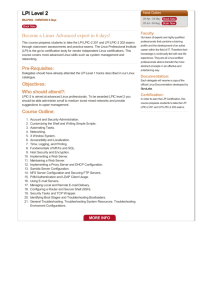
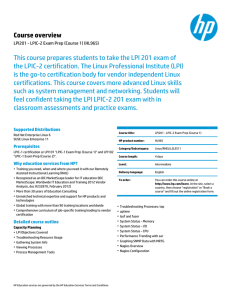
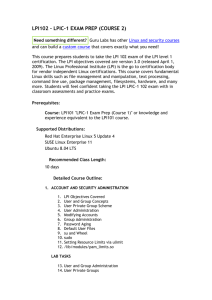

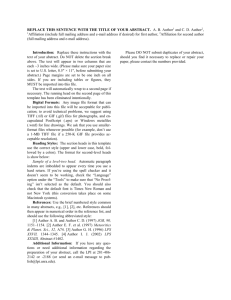
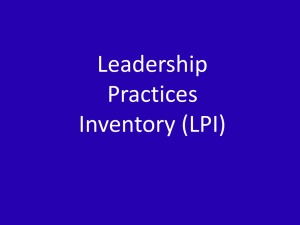


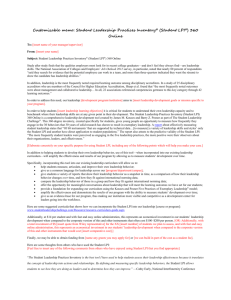
![IEEE 802.15.4 stack for Linux / kernel / [96de0e] /arch/m68k](http://s3.studylib.net/store/data/007481728_1-1cbbaf6005d58ec05ddcee46b1d651a9-300x300.png)

